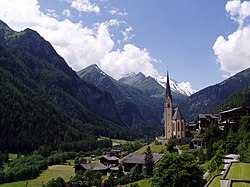| Carinthia | |
 | |
Location  | |
Coat of arms and flag  | |
| State | Austria |
|---|---|
| Capital | Klagenfurt am Wörthersee |
| Surface | 9,535 km² |
| Inhabitants | 558.997 (2010) |
| Tourism site | |
| Institutional website | |
Carinthia is one of the federal states (Bundesland) ofAustria.
To know
There Carinthia (in GermanKärnten, in SlovenianKoroška) is the southernmost of the nine states (Bundesländer) ofAustria.
Geographical notes
It mainly consists of a basin within the Alps, in which the Carnic Alps delimit the southern border with theItaly (provinces of Belluno in Veneto and of Udine in Friuli Venezia Giulia) and the Slovenia (regions Lower Styria/Štajerska, Carinthia/Koroška is Upper Carniola/Gorenjska). The chain of Tauri separates it from Salzburger Land North. To the east we find the land of Styria, while in the west Carinthia forms a continuous valley with East Tyrol (Osttirol) (part of Tyrol). It is best known for its magnificent lakes. The main river in the region is the Drava (Drau).
When to go
Carinthia has a continental climate, with warm, moderately humid summers and long, harsh winters. There have been exceptionally dry winters in recent years. A typical phenomenon in autumn and winter is the thermal inversion, which involves the absence of wind, a thick fog that covers the frozen valleys and traps pollution, while on the peaks of the hills and on the mountains we generally find a pale sun.
Background
In historical times this region was inhabited by the Paleoveneti and the Celts Carnii, hence the name of the region (in fact a part of it is located in Italy with the name of Carnia). The Duchy of Carinthia was historically part of the Holy Roman Empire until its dissolution in 1806, later becoming a crown territory under the Habsburg Empire. With the dissolution of the Empire after the First World War and after the Yugoslavian attempt to annex the region by force in 1919, a plebiscite in the southern areas of the Land, held on 10 October 1920, under the control of the League of Nations, sanctioned the will of Carinthia to belong to theAustria. In 1945, at the end of the Second World War, for the second time the Yugoslavs attempted the annexation of the southern part of the region, but still had to give up.
Spoken languages
The population is mostly native speakers German with a single (and easily identifiable) dialect. There is also a minority of native speakers Slovenian, speaking various Slovenian dialects of the Carinthian lineage, amounting to about 15,000 - 40,000 people, concentrated in the south-east of the region.
Territories and tourist destinations

1. Route on the A2
Assuming we are entering from Italy, the first cross-border city we will meet is Villach (Villach). Going forward on the A2 we will meet the following locations:
- Wörthersee —
- Klagenfurt am Wörthersee —
2. The North West
If from Villach instead we take the A10, part of the E55 that leads to Salzburg we will enter the valley of the river Drau to the city of Spittal an der Drau, district capital. The main attractions of the area are the following:
- Millstat - Small town on the shores of the lake of the same name.
- Bad Kleinkirchheim - Important ski and spa center just beyond the Millstatt lake
- Gmünd - Location where Ferdinand Porsche he started his first automobile factory destined later to become famous all over the world. TO Gmünd there is a museum dedicated to the car brand.
- Malta - About ten km from Gmünd, in the homonymous valley
2a. The southern side of the Hohe Tauern
- Mallnitz - On the southern slope of the Hohe Tauern, Mallnitz is part of the Ankogel ski area. Other locations in the area are Flattach is Stall
- Heiligenblut - At the foot of the Großglockner, the highest mountain inAustria ( 3,798 m) Heiligenblut is a holiday center with many possibilities for excursions in the surrounding area, also renowned for being included in the Tour of Italy in 2011. The Großglockner road is considered one of the most scenic in Europe.
3. Gail Valley (Gailtag)
From Villach taking the state road 111 we will enter the Gail valley, a tributary of the Drava. The main center is Hermagor, on the shores of Lake Pressegger. A little further on is the Nassfeld ski area (Pass of Pramollo), in the Carnic Alps, one of the largest in Carinthia with slopes extended for 110 km.
